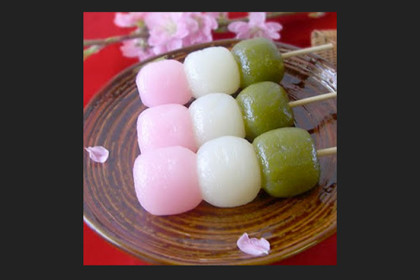
Japanese sweets are called wagashi, usually they’re based on natural ingredients such as rice, beans and fruits, and are decorated with leafs and edible flower petals. They contain little fat and less calories than other types of sweets. Their history is very ancient: today’s recipes were in fact influenced by Chinese and Western ones.
There are lots of occasions when they enjoy these specialties. For example, a nice cup of green tea, which is very bitter, is balanced out by wagashi, very sweet, and during the day or on a special occasion, such as the different festivities of the Japanese calendar, or simple to make a gift to friends and acquaintances, which can be saying sorry, thanks, encouragement, to avoid bad luck or as a souvenirs.
The wagashi have an important connection with the seasons, which is often depicted in desserts such as leaves, flowers, pools of water or the characteristic fruit of the season. In addition to sight, other senses are satisfied too: because of the name, special consistency, taste and aroma of the sweet, which reflect the ingredients. Speaking of ingredients, the main ones are rice, flour, starch, sweet beans (from which a type of marmelade which is used comes, the anko), sugar, gelatine and fruits like chestnut and cachi, and pumpkin.
There are other types of sweets, too, in Japan, which are originated from the West, the yogashi, made with eggs, dairy products, cocoa and others such; which the Japanese really like – especially youngsters – because they prefer richer and sweeter tastes, and because these can be served after a meal, which is not true in the case of the wagashi. However, there are also some sweets somewhere between Japanese and Western ones, in which traditional and foreign ingredients are combined to create sweet bean flavoured ice cream, for instance.
The most common instruments to make wagashi are cookie cutters with traditional motifs, made of metal or wood to shape the sweets, steam kettles to kook them and in order to maintain all the nutrients. They’re rich in fibre, proteins, vitamins, mineral salts, but especially in sugar and carbohydrates, which thanks to the small amount of fat contained and the small portions, do not really influence your diet at all. You should consume these sweets on the same day as they were prepared, or alternatively you can freeze them (and unfreeze them at room temperature for 2-3 hours before consumption).
It is also possible to obtain them where they are sold: there are many pastry shops, tea houses and local chains – like Toraya or Minamoto Kitchoan – established to taste and/or buy these sweets in Japan. The price is not exactly cheap, the traditional wagashi or the packaged ones cost about 2-3 euros each, while those “every day” ones cost about one euro per sweet.
But where to find them in Italy?
In Milan, the restaurant named Oasi giapponese presents a small selection of wagashi and offers catering services, while some Japanese shops sell wagashi packaged in a kind of “newspaper” packaging. To taste the “high” categories, the sweets for special occasions, we need to go all the way to Paris to the tea salon Toraya.
 English
English  Italiano
Italiano 



